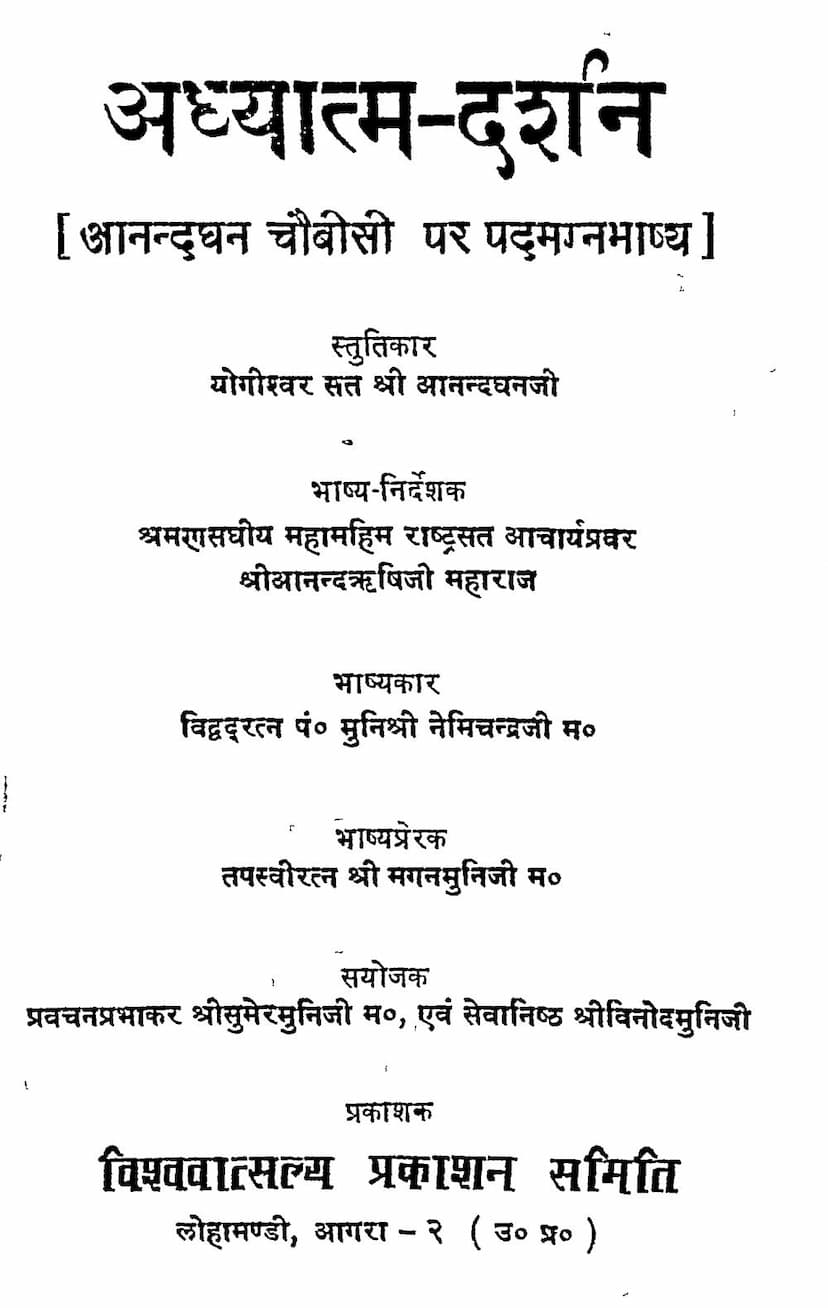Adhyatma Darshan
Added to library: September 1, 2025

Summary
Based on the provided text, here's a comprehensive summary of the Jain text "Adhyatma Darshan" by Anandghan and Nemichandmuni:
Overall Purpose:
"Adhyatma Darshan" is a profound Jain text that explores the path to spiritual enlightenment and ultimate liberation (Moksha) through the lens of devotional hymns (pads) dedicated to the twenty-four Tirthankaras. The text aims to provide a deep understanding of spiritual principles, the nature of the soul, the path to detachment from worldly desires, and the realization of the highest virtues.
Key Features and Content:
The book is a commentary (bhashya) on the "Anandghan Chaubisi," a collection of hymns by the revered Jain yogi, Saint Anandghanji. The commentary itself is attributed to Pandit Muni Nemichandji, under the guidance of Acharya Shree Anandrishi Ji Maharaj.
The summary highlights the following key aspects:
- Spiritual Philosophy: The text delves into "Adhyatma Darshan," a philosophical exploration of spirituality. It uses the veneration of the twenty-four Tirthankaras as a medium to convey spiritual knowledge.
- Devotional Hymns: Saint Anandghanji's "Chaubisi" (a set of twenty-four compositions, each dedicated to a Tirthankara) forms the basis of the work. These hymns are described as devotional, simple, and rich in spiritual content, covering topics like:
- Philosophy and Dharma (religion/duty)
- Worship and Devotion
- Religious Practices
- Adoration of the soul's highest virtues
- Spiritual strength and bravery
- Realization of the Supreme Soul (Parmatma)
- Meditation and mental discipline
- Commentary's Depth: The commentary by Muni Nemichandji is highly praised for its detailed, clear, and profound explanation of the subtle truths embedded in Anandghanji's verses. It aims to unfold the philosophical and practical aspects of the hymns from various angles, filling a gap in existing literature.
- Inspirational Figures: The book acknowledges the contributions of several spiritual guides and scholars:
- Anandghanji: The revered poet-saint whose hymns are the foundation.
- Nemichandmuni: The insightful commentator who elucidated the hymns' meanings.
- Anandrishi Ji Maharaj: The guiding light and inspiration behind the commentary.
- Maganmuniji: The key inspiration behind the entire project, motivating the writing and publication.
- Other Contributors: The text also mentions the support and contributions of various individuals and committees involved in its publication.
- Rejection of Ritualism and Superstition: Anandghanji's hymns are noted for their critical stance against blind adherence to traditions, rituals, and rigid dogma. His thought is described as revolutionary and reformist, emphasizing a direct spiritual experience over mere external practices.
- Emphasis on Inner Realization: The text stresses that true spirituality is not about external rituals or following traditions blindly. It's about the inner experience, a direct realization of the soul's true nature, and the effacement of ego and divisive notions. The ultimate aim is the experience of oneness and the resonance of "Ek ev Bhagwanayamatma" (The soul alone is the Supreme Being).
- Literary and Spiritual Merit: Anandghanji's poetry is characterized by its profound spiritual insights, lyrical beauty (madhurya), eloquence (pranjalta), and dignified language (garima). His focus was on conveying the essence of the "Shanta Ras" (the sentiment of peace and detachment), which he successfully achieved.
- The Power of Love for the Supreme: The hymns explore the concept of divine love, distinguishing it from worldly, conditional love. It's described as a love that is unconditional, eternal, and selfless, leading to the highest form of spiritual union.
- Critique of Superficial Practices: The text subtly critiques practices that are merely performative or driven by external show, emphasizing the importance of genuine internal devotion and understanding.
- The Role of the Guru and Scriptures: The importance of a qualified Guru and the scriptures (Agamas) is highlighted as essential guides in understanding and practicing the spiritual path. The text emphasizes that scriptural knowledge must be followed by practical application in life.
- Personal Transformation: The core message is about transforming oneself through spiritual knowledge and practice, leading to inner peace, liberation from suffering, and the attainment of the ultimate state of bliss.
Key Themes and Concepts Discussed (across the stutis):
- Sachi Paramatm-Preeti (True Love for the Supreme Soul): This is a recurring theme, contrasting with worldly love and emphasizing its unconditional and eternal nature.
- Paramatm-Path ka Darshan (Seeing the Path to the Supreme Soul): The text explores how to discern the true spiritual path, highlighting the limitations of external sensory perception and the need for divine or inner vision.
- Paramatma ki Seva (Service to the Supreme Soul): This section emphasizes that true service is not external ritual but the purification of one's own soul and living in accordance with its inherent nature.
- Paramatm-Darshan ki Pipasa (Yearning for the Vision of the Supreme Soul): The text describes the intense longing for spiritual realization and the obstacles on this path, including the confusion caused by various sects and philosophies.
- Paraspavirodhi Gunon se Yukt Paramatma (The Supreme Soul Possessing Contradictory Qualities): This section delves into the paradoxical nature of the divine, where seemingly opposite qualities coexist, resolved through the lens of multiple perspectives (anekanta).
- Manovijay (Conquest of the Mind): A significant portion addresses the struggle with the restless mind and the need for discipline and spiritual practice to control it.
- Paramatma se Shanti ka Samadhan (Solution to Peace from the Supreme Soul): The text explores the nature of true peace and its attainment through spiritual practices and understanding.
- Anandghan-pad prapti (Attainment of the State of Anandghan): This refers to the ultimate state of blissful consciousness, the goal of spiritual practice.
- Vachana-Viveka (Discernment of Truth from Falsehood): The importance of discerning true spiritual teachings from superficial or misleading ones is a key takeaway.
In essence, "Adhyatma Darshan" serves as a guide for spiritual seekers, illuminating the path to self-realization and union with the Divine through the profound teachings of Jain philosophy and the devotional verses of Saint Anandghanji, explained with great clarity by Muni Nemichandji.